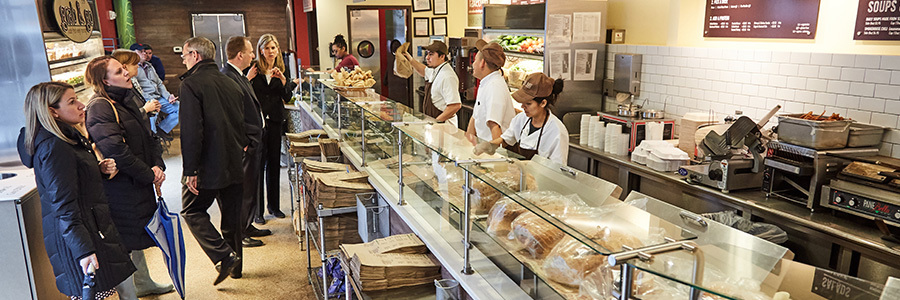Setting Website Goals that Get Results
When designing a new website for your business or organization, the most important step is planning and deciding what your website goals are. Beginning the project without clear and measurable objectives can result in a website that meets neither business objectives nor user needs. With that in mind, think about what you want your new website to achieve for your business or organization.
- Who are your users?
- How will they use the website?
- What are their needs from the site?
- What do you want them to be able to do on your website?
These questions should be at the core of your goal planning.

Identify Your Target Audience
Identifying your target audience is one of the most important elements of putting together your website goals and strategies. Though you will welcome one and all to your website and any brick and mortar church, business, store, or restaurant, there is a certain subset of people that find your organization the most helpful to them. Honing in on this subset will make the job of setting website goals much easier.
- Who is your target audience?
- Do they live in a certain geographical area near your location, or are they located around the country?
- Do they belong to a certain demographic – young families, business professionals, seniors or single people?
Think about your favorite customer, member, or client. If you could clone that person, who would that be, and what is it about them that makes them your best customer?
Think about your favorite customer, member, or client. Who would you clone? Why? Share on X
Set Smart Goals
When setting goals, there is a simple acronym to remember: SMART. SMART goals have been a part of business ideology for decades, and they still are useful today. They help keep everyone focused on the goals and increase productivity. SMART means that the goals are Specific, Measurable, Achievable, Relevant and Time-bound. Now let’s unpack each of those:
Specific
This means your goals should not be simply to increase the size of your congregation, membership, customer base or revenue, but rather to add 115 members or increase your monthly revenue by $6250.
Measurable
To meet your goals, you need to be able to measure your goals. Keep that in mind when setting them, and also set up the mechanisms or processes to measure them regularly.
Achievable
Would you like to double your restaurant revenue? Have the church full every Sunday? Of course you would. But is that particular goal achievable within the short-term? Keep your goals achievable, and adjust them upwards as you meet them.
Relevant
If you are trying to increase your nonprofit organization’s donorship, which goals are relevant? Tracking the number of people that view your website, how many people sign up for your newsletter, and the amount of online donations received, for starters. For restaurant owners, tracking newsletter sign-ups, online orders, and coupons redeemed would be relevant website goals.
Time-bound
Figure out the length of time needed to meet your goal so that you can put together the game plan you need to get there. This number can vary depending on your organization and your goal, but you need to pick a target date and get to work!

Why is it Important to Establish Website Goals for a New Project?
Knowing what you want to achieve, and the steps you need to take to get there, are keys to setting the website goals for your project. Having website goals set up before you get started provides clarity to everyone involved, from the designer and developers to writers. Features can be implemented effectively when the priorities are well-known.
Tracking what users do online and on your website can be achieved with analytics. This gives you quantitative data on how your website goals are working and lets you know what isn’t working well. To get accurate measurements and make the process easier, have your website goals well-defined and easy to track.
As mentioned, setting up SMART website goals for your nonprofit, church or business is one of the keys to making it successful. So, what type of goals should you consider for your website? Here are a few ideas:
[ism-social-followers list=’fb’ template=’ism_template_1′ list_align=’horizontal’ display_counts=’true’ display_full_name=’true’ display_sublabel=1 ]
Restaurant website goals
Many restaurant owners are extremely busy, and have built their businesses on excellent service, customer satisfaction and word of mouth. But that only gets a business so far, and then investing in your website, website goals and online marketing can help you grow exponentially. For instance, you can add online ordering or reservations when relaunching a website or building a new one.
Building a website with SMART goals is one of the keys to online growth. Share on XInstead of a generic goal such as increasing online sales, effective SMART website goals are specific.
Increase online sales from the website by 20% by July.SMART GOAL
Another ineffective goal is say you want to get new contacts from the website. A more specific SMART website goal would be:
Have 5 or more people interested in opening a franchise fill out a contact form on our website at least 3 of the next 4 months.SMART GOAL
For a restaurant website, the major goal is often to bring in additional customers. It’s hard to track that type of metric, but you can do it. Your SMART goal might be:
Bring in 50 online orders each month from customers who a coupon from our email weekly newsletter.SMART GOAL
Another SMART goal could be set up using an online reservation system; track where your reservations are coming from and set a specific goal for your online reservations.
Additionally, online reviews are extremely important for restaurants, so a SMART website goal should be to encourage customers to leave glowing reviews on Yelp, Google, Facebook or Trip Advisor, and to have a total of 50 reviews (5-star ones!) within 6 months. Keys to increasing positive reviews are encouraging customers who have a positive experience to leave one and making them easier to find by adding links on your website.

Nonprofit website goals
Donations are the lifeblood of nonprofit organizations, so set your SMART goals to increase donations. Donors are especially receptive when they know how their money will help, so be sure to give them that information.
Nonprofit organizations do well when they set up sub-goals for specific purposes. For instance, your nonprofit organization that is involved in serving the homeless might set up a SMART campaign goals on your website during a particularly cold snap to raise $3,000 to house 100 homeless people overnight.
Raise $3,000 this month to house 100 homeless people overnight during the coldest days.SMART GOAL
Of course, longer term projects can also be highlighted on the website as well. Perhaps you have a goal to purchase and rehabilitate a building to house homeless people. Images and stories about the people being impacted and how this building will help the homeless transition to work and apartments of their own will inspire people to help make that goal a reality. Again, make it a SMART website goal. Do you need $150,000 to get it done? What is a reasonable length of time to raise that much money from your donors? 12 months?
Raise $150,000 within 12 months to fund the renovation of a building for homeless people. Start date is X.SMART GOAL
Another SMART goal could be to add users to your email list knowing that those users will turn into donations for your nonprofit projects.
Add 400 people interested in the work we are doing to our email list from the website by the end of May.SMART GOAL

Church website goals
For today’s churches, SMART website goals often surround the need to increase the church membership and the size of the Sunday congregation. What are some ways to do that using your website? One SMART goal idea is to have a drive to increase the subscribers on the church email list.
Have at least 90% of our congregation (as measured as 1.5x average weekly attendance) subscribed to our email list by the end of the year.SMART GOAL
By having current members sign up on your website, they’ll be aware of happenings within the church family, and can help with drives to increase the congregation size. If you already have your members on your mailing list, set a SMART goal that involves getting people on the fringe of your church or in the community to sign-up for your newsletter.
Another one of your SMART website goals could be increasing the number of children attending Vacation Bible School. One of the objectives for VBS is often to reach those families that are not already connected with a church. So, offering VBS could be one of the ways your church does that. In this case having a goal to have a certain number or percentage of kids attending VBS not be from your church or another church in the area, might be a smart goal.
Have at least 50% of the kids that attend this year’s VBS be unchurched kids. Registration is through the website.SMART GOAL
When this is clearly defined it can help rally your staff around the reason behind VBS and clarify the objectives, target audience, content and marketing strategy.
Goals like having 25 percent of visitors to the church mark on their guest card that they found the church through the website is specific and measurable, and you can set up your time goal as 3 months or 6 months or some other relevant and achievable timeframe.
Over the next 3 months, have 25% of visitors to the church indicate on their first time guest card that they found the church through the website.SMART GOAL
How about a SMART website goal that makes it easier for current church members to invite their friends and family members to Easter? You can give out a special invite card that gives their first time guest a free speciality coffee drink when they visit. You can have your coffee shop volunteers track the number of cards they receive.
Encourage church members to invite friends using a special invitation that gives their first time guest a free speciality coffee drink. Send the card out via email and social media. Collect 200 cards by Easter.SMART GOAL
Client Success Stories
We have helped businesses of all types, from restaurants to retail stores, service organizations, churches and nonprofits all achieve extraordinary results with a fresh, new website focused on achieving their SMART goals. We can do the same for you!
The Mdprayer.org achieved participation of more than 100 people attending their physcian’s prayer breakfast after we redesigned and streamlined their website. We made their online registration easier and made it a simple process to send out frequent email blasts to their list of subscribers. That attendance was a record for them, and a 25 percent increase year over year.
Have at least 100 people attend the Physician’s Prayer Breakfast in 2016 (a 25% increase over 2015).MDPRAYER.ORG
We also redesigned Brownbagonline.com website and helped them increase their website trafffic by over 30 percent over the previous year, along with reducing their bounce rate from over 25 percent to just 1 percent! That means people came to their website, stuck around, and placed more online orders!
Reduce the bounce rate on our new website to below 5% within 3 months of launching to increase online orders and engagement.BROWNBAGONLINE.COM

Ready to Get Started?
If you are ready to get started, download the FREE SMART website goals worksheet. This tool will help you clarify your website goals before you hire a professional web design company. Get those crystallized before you discuss how you want it to look or feel; it truly is the most important element of website design.
Once you have your website redesigned or launched, how do you know that it is successful? Obviously, it probably looks better than the one you previously had, but how do you prove that the investment is helping your business or organization advance? This is where your SMART website goals help! Comparing them to your achievements over time will let you know if the website hit its mark, or if you need to tweak it or add additional website features. Tracking the progress of your website goals is important, and will help you keep moving forward.
Changes like these bring positive results, and building or refreshing your website will help you achieve your website goals!
Share this post
We focus on beautiful web design that delivers results for your organization. Our specialty is creating customized WordPress websites.
About Us
Johnny Flash Productions
Johnny Flash Productions is a creative agency based outside of Washington D.C. that focuses on digital strategy, web design and development, graphic design and event production that helps businesses get better results from their marketing.
John has been managing my website SEO and Google Ads for only a few months now and his services have already generated profitable leads. I can’t say enough about his company’s professionalism, promptness and results oriented approach. Hiring his company has been an excellent business decision!!

Johnny Flash Productions is a company that truly cares about their clients, this is obvious by not only their work ethic but they also the way they put their heart into every project they complete.
Johnny Flash Productions was a pleasure to work with, we look forward to working with them again in the future.

I was looking for a web designer who was not only talented, but could deliver - and keep delivering what I needed month after month. The team at Johnny Flash Productions brought ideas to the table that complemented what I wanted to do with my website and their design exceeded my expectations.
I was willing to pay more for their continuing monthly service than I had paid previously because they laid out what I could expect from their team. So far, they have under promised and over delivered.

Exceeded all expectations in their abilities to professionally evaluate and customize our company WordPress website. Above all else, their customer service is the best I've dealt with in a long time with any company I've worked with in the past. I definitely recommend Johnny Flash Productions to anyone looking for exceptional service, professional detail and customer support.

I would like to thank Johnny Flash Productions for there great service my company has been able to get to get to the top of Google searches in half the time most companies take. I am now receiving 3 to 5 viable leads a day that all lead to service work for my company. And I can not thank them enough for all of there support with my site and maintaining it for me.

Their knowledge of SEO and integration of social media channels improved our church's online impact.

We had a phenomenal experience working with the Johnny Flash Productions team for our new website, SEO, and logo. We are excited and unequivocally satisfied with the results. Our website has received numerous positive reviews from our clients, associates, and friends. And their SEO services have already brought us new clients who found us online.

We began collaborating with Johnny Flash Productions in January 2023 with the primary goal of optimizing our SEO and achieving visibility on Google's first page. During our initial meeting, John provided thorough explanations and informed us that it could take up to six months to see results. Fast forward, and our company consistently appears on the first page of Google.

I've had an exceptional experience working with Johnny Flesh Productions for my website's search engine optimization. John and his team are not just experts in SEO, but they also make the process engaging and informative. Their prompt responses and unwavering professionalism stand out, making every interaction a pleasure. If you're looking for a team that delivers outstanding results and values client collaboration, Johnny Flash Productions is the go-to choice. Five stars all the way!"

JFP is amazing. My new website is very clean, conveys exactly what I want to my clients, looks way better than the competition, and will be the base for my company moving forward. And now I have a great working relationship with Johnny Flash Productions for all of my SEO and website needs. Don't hesitate to go with JFP, they're honest. They rock!

We had a great experience working with Joli and the team at Johnny Flash. Their whole process was very helpful to shaping and sharing our website message.

When we all get a little too busy, sometimes we forget to say a heartfelt "Thank You"! I am so grateful that God led us to partner with you. I know good things will come from our hard work done together in His name. The website is terrific. Pure and simple.
Thanks for your expertise, guidance and always friendly attitude.

John and his team at Johnny Flash Productions did an amazing job on our new company website! John was very patient and professional throughout the entire process and always responsive to any request we had.
I would definitely recommend their services to anyone looking to create a website!

Johnny Flash redesigned both our church website and our preschool website to align with our new branding, helped us switch web hosts and met some tight timelines as well. John and his team are always professional, have fresh ideas and are quick to respond to questions.
They also worked us to revamp both websites within our set budget while still providing a quality web design and custom look. If I could give them ten stars, I would!

I must admit that I was not crazy about revamping our website, primarily due to the time commitment and cost. However, in looking through the updated content this morning, the new website looks terrific and was well worth the time and expense.
Thanks to you and your team for all of your hard work.

I would like to thank Johnny Flash Productions for there great service my company has been able to get to get to the top of Google searches in half the time most companies take. I am now receiving 3 to 5 viable leads a day that all lead to service work for my company. And I can not thank them enough for all of there support with my site and maintaining it for me.

John has been managing my website SEO and Google Ads for only a few months now and his services have already generated profitable leads. I can’t say enough about his company’s professionalism, promptness and results oriented approach. Hiring his company has been an excellent business decision!!

We have been very pleased with our website design experience with Johnny Flash. We appreciated how their structured process enabled our website team to prioritize our goals for the project and develop a final product customized to meet our individual needs.

Johnny Flash did a great job on our new Wellesley Hills Congregational Church website. Delivered on time and on budget. They helped us shape good content as well.
We were so satisfied we had them redo our Wellesley Nursery School in the Hills website also.

Johnny Flash Productions is a company that truly cares about their clients, this is obvious by not only their work ethic but they also the way they put their heart into every project they complete.
Johnny Flash Productions was a pleasure to work with, we look forward to working with them again in the future.

Was a pleasure to work with Johnny Flash Productions to walk through the full life cycle of a complete redesign of several of our ministries websites. Working with people who are experts caused us to think outside the box in how we really tell our story through our website.
The entire team was great to work with and the value has been incredible! God is good!

This process was so much easier than I expected. John listened carefully to what I was expecting to accomplish with our website and kept me focused on our objectives.
We are now able to register preschool students online (especially important during COVID). Parents are very happy that now they have the option to pay by credit card. I would highly recommend this company!

Such an amazing service. A beautiful website that has already gotten the practice new business. John kept us on track so that our website was up and running in the time allotted. Thanks so much. Highly recommend.

It has been such a pleasure working with John and Nicole to develop our WordPress website. The team is very professional and worked closely with us during the entire process. We couldn't be happier with the result, we love our new website.
I definitely recommend Johnny Flash Productions!

I was looking for a web designer who was not only talented, but could deliver - and keep delivering what I needed month after month. The team at Johnny Flash Productions brought ideas to the table that complemented what I wanted to do with my website and their design exceeded my expectations.
I was willing to pay more for their continuing monthly service than I had paid previously because they laid out what I could expect from their team. So far, they have under promised and over delivered.

Professional, knowledgeable, friendly! Everything you could ask for in a website development firm/SEO company. Johnny Flash Productions is the best website development firm and SEO firm in Northern Virginia!

They did excellent design work, were professional and responsive. They were an absolute pleasure to work with, and I plan on using them for future projects.

Working with John and his team has been such a wonderful experience! They consistently go above and beyond to quickly complete our requests, and it's great working with a team of true experts.
I highly recommend them for anyone looking for WordPress developers.

We chose Johnny Flash Productions because I knew the person, John Falke. Relationships are important. Knowing character is important and relevant to business decisions. Knowing whether a person/business will stick by their word is important along with can they perform.
A company that can perform is good, but if they do not stick by their word, skill means nothing. You produced a great product, worked with us, gave a fair price and kept us on task.

We used Johnny Flash Productions to help us recreate our website and to make it more visually appealing and more current. Working with them was very pleasant and easy. They really listened to what we were looking for and worked within that framework.
I would highly recommend them. I am happy to provide a reference or answer any questions that you may have.

Exceeded all expectations in their abilities to professionally evaluate and customize our company WordPress website. Above all else, their customer service is the best I've dealt with in a long time with any company I've worked with in the past. I definitely recommend Johnny Flash Productions to anyone looking for exceptional service, professional detail and customer support.

We have a fabulous website thanks to their excellent process.

Excellent WordPress Web Designer, we are so lucky to have them design our website we were very satisfied with the results!

John and his team are great to work with. We have worked with them on a broad range of projects including logo development, campaign materials and website design. They are a great partner!

Johnny Flash Productions was a joy to work with! They helped our church completely re-do our website. They also helped us refresh our look and logo. We have had many people comment on how much they love our new website and how much easier it is to navigate.

John Falke and Johnny Flash were incredible to work with and produced a very professional and progressive website for Covenant Park Consulting and were completely responsive to our vision and goals.

Johnny Flash Productions and their team were aces to work with. Their process was simple, and project schedule was on target.
More importantly, their Storybrand mindset opened us up to a whole new world for our website presence, business development and even our own client communication.

Johnny Flash Productions has played an integral role in the growth of our business. From logo redesigns, website design and management, fliers, banners, signs and more, they have done an incredible job of taking our ideas and WOWing us with his visual designs.
John's knowledge base allows them to understand our ideas and concepts and bring it all together in a professional, well thought out deliverable. Their work has always exceeded our expectations in both quality and speed.
We look forward to continuing our long business relationship as he continues to stay on top and ahead of visual marketing trends without losing it’s classic appeal.

John, Joli and Team provided the path forward for us on how to take our desire to have a brand new website to getting it launched and live. We started at a high level of who we were and what we wanted to accomplish with our website.
John provided an up front schedule of what tasks would be completed by when from their team.
There were tweaks along the way that we would make and feedback given, and it was always well received with the changes being made in a timely manner. Thanks John and Joli.

Johnny Flash Productions helped breathe new life into Immanuel’s online presence with their wonderful redesign of our website. Aside from their consummate professionalism, flexibility and keen attention to detail, they were an absolute pleasure to work with.
It had to be a daunting task to be presented with the enormous number of expectations , hopes and ideas generated from our church’s website committee throughout the course of the website re-design, but if anything, Johnny Flash's resulting work exceeded all expectations.
I’m sure I can speak for all of us on the committee when saying that we’d heartily recommend Johnny Flash to any church or organization in need of a skilled, knowledgeable, easy-to-work with design company.

John and his team do top quality design work, website work, and just about anything you would need to have a dynamic presentation in both print and digital media. Incredibly talented and innovative, you can call him with a "thought" that comes back to you better than you ever imagined. Truly professional and talented, I could not recommend more highly.

Johnny Flash Productions gets results building stand-out websites that are optimized for success! Their team of professionals worked quickly to get to know my business and developed a plan of action. Their designers developed an amazing design that exceeded our expectations. If your organization or business is looking to build or improve your presence online.
I highly recommend Johnny Flash Productions!

I recommend Johnny Flash Productions because they respond promptly and with honesty when requesting their services, they are very professional and I am a satisfied client!
They fulfilled my expectations with the website and branding project. It has already been a success and helped us reach our goals for our business. Thanks Johnny Flash Productions.

I have worked with Johnny Flash Productions on 3 of my own websites and recommended Johnny Flash productions to two other family members who were also in need of new websites. We have all had an exceptional experience during the process.
The staff are very responsive, organized, on time and they follow through until the work is complete. We valued them so much that we use them for our monthly maintenance and they help with our advertising online.

We found Johnny Flash Productions to be professional and a pleasure to work with. Their industry knowledge and creative approaches were incredibly helpful.
Our new website exceeds our expectations and we look forward to continuing our relationship with Johnny Flash Productions with their responsive and ongoing website upkeep, maintenance and SEO.

I cannot begin to speak highly enough of Johnny Flash Productions. I was first alerted to their company by doing a Google search & found only one company around with so many 5-star reviews, so was curious if they could all be real. I found through working with John & Eowyn & the Johnny Flash team that we were able to collaborate to create the perfect website for our organization.

We regularly get rave reviews about our website. Often other non-profits have asked us for a referral. Johnny Flash was easy to work with and has always been responsive to our needs. They provided several built in tools that help keep our website from becoming stale.

We are truly grateful for our time working with John and his team. They were able to manage a full redesign within a relatively tight timeline and delivered an impressive site that also worked well through mobile devices as well.
They kept us on schedule as well and were a pleasure to work with. The team continues to be incredibly responsive following the initial launch.

Efficient, effective and professional - Johnny Flash Productions did an awesome job of rebranding and migrating our WordPress website. We launched last week and there is positive feedback all around for the sleek, new, mobile friendly look.

Johnny Flash and team approached the project with as much passion as we had (we're a very passionate team) for the site and logo refresh. We worked through the logo and website designs and within a couple of weeks, it felt as if we were all one company.
The team was super responsive, understood our vision for the logo/website and communicated clearly every step of the way.

The Johnny Flash team is incredibly skilled, attentive and patient. We are very happy with our new WordPress website!

Our organization couldn't be happier with the beautiful website Johnny Flash Productions created for us. They helped streamline thousands of components from our previous site into a site that portrays the mission of our organization and tells the story of our purpose while bringing in and engaging new and returning visitors.
We wouldn't hesitate to use them again and have already recommended them to several people who have seen the quality of our new site.
We have also seen a remarkable uptick in response in those who have gone to the site just in the first few weeks since launch in signing up for future communications. That is the sort of prolonged engagement we have been looking for, and Johnny Flash Productions delivered beyond our hopes.







